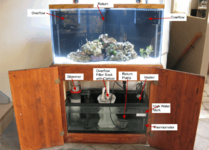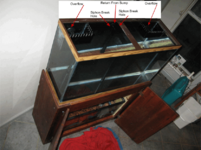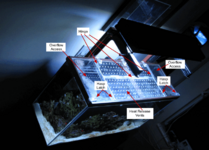Good point Joe! I did NOT mean to not put a secure top on the tank!!!! The lip can support the top (and this is what we do for most of our tanks) but is put there to help with escape attempts when the lid is open for cleaning and feeding.
-
Looking to buy a cephalopod? Check out Tomh's Cephs Forum, and this post in particular shares important info about our policies as it relates to responsible ceph-keeping.
You are using an out of date browser. It may not display this or other websites correctly.
You should upgrade or use an alternative browser.
You should upgrade or use an alternative browser.
O. Briaerus tank plans
- Thread starter copy111
- Start date
- Joined
- Nov 7, 2010
- Messages
- 9
Plan edit!
50 gallon tank
30 gallon sump
Tunze DOC protein skimmer 9016
200 gallon filter, sinc theres controversy I'll go right down the middle
2x penguin 660 powerhead
70 pounds of live rock, going to put as much as I can in the smaller tank
1 inch fine sand
2x glass heater
1x flourescent lights
1x PC lights
50 gallon tank
30 gallon sump
Tunze DOC protein skimmer 9016
200 gallon filter, sinc theres controversy I'll go right down the middle
2x penguin 660 powerhead
70 pounds of live rock, going to put as much as I can in the smaller tank
1 inch fine sand
2x glass heater
1x flourescent lights
1x PC lights
- Joined
- Aug 13, 2009
- Messages
- 1,740
Be careful about over packing your sump. Detrius and other debris will accumulate over time and with all that rock it may make out difficult to clean. Decent flow through the rocks will help with this issue.
- Joined
- Sep 25, 2006
- Messages
- 572
I think a good skimmer is very important, and you are planning to get a really good one, so good job on that.
I still think that a 50 gallon tank might be too small, unless you get an O. Hummelincki.
I agree with skywindsurfer that live rock needs lots of flow to do it's work, so if you are going to pack it so tightly, be sure to put pumps in the sump to get lots of flow around the rock, and avoid dead spots and junk settling.
PC lights might be too bright for an octopus, you might want to look around Tonmo to see what people have said about them.
I'm not a big fan of using powerheads for water motion in the tank. I prefer koralia pumps or even better, Tunze Nano Stream pumps. They move more water, and they don't produce such a focused blast as a powerhead. They also use much less power, and so add much less heat to the system (which I care about because I have a bimac at 56 degrees).
When you say "200 gallon filter" you could mean anything. There are a lot of ways to keep water clean, and while just using lots of live rock seems to work best for most reef tanks, I'm skeptical about the prevailing belief that most other filtration methods (bio-balls, canister filters, etc) "have no place" in a marine system. I've kept octopus, strawberry anemone and gorgonians in a cold heavily fed tank for years using a wet/dry trickle filter, and no live rock at all, and it works for me, so just do your homework, and pick a method that will work for you. I think using live rock (with a good skimmer) while expensive, is probably the simplest and safest way, to go, but if you are careful you will avoid the pitfalls involved with other methods of filtration. BTW, I hate canister filters because I learned the hard way that if you wait to long to clean them the mechanical filter could get blocked, causing increased back pressure, resulting in an o-ring failure and a flood. I need a system that is forgiving about irregular maintenance.
I still think that a 50 gallon tank might be too small, unless you get an O. Hummelincki.
I agree with skywindsurfer that live rock needs lots of flow to do it's work, so if you are going to pack it so tightly, be sure to put pumps in the sump to get lots of flow around the rock, and avoid dead spots and junk settling.
PC lights might be too bright for an octopus, you might want to look around Tonmo to see what people have said about them.
I'm not a big fan of using powerheads for water motion in the tank. I prefer koralia pumps or even better, Tunze Nano Stream pumps. They move more water, and they don't produce such a focused blast as a powerhead. They also use much less power, and so add much less heat to the system (which I care about because I have a bimac at 56 degrees).
When you say "200 gallon filter" you could mean anything. There are a lot of ways to keep water clean, and while just using lots of live rock seems to work best for most reef tanks, I'm skeptical about the prevailing belief that most other filtration methods (bio-balls, canister filters, etc) "have no place" in a marine system. I've kept octopus, strawberry anemone and gorgonians in a cold heavily fed tank for years using a wet/dry trickle filter, and no live rock at all, and it works for me, so just do your homework, and pick a method that will work for you. I think using live rock (with a good skimmer) while expensive, is probably the simplest and safest way, to go, but if you are careful you will avoid the pitfalls involved with other methods of filtration. BTW, I hate canister filters because I learned the hard way that if you wait to long to clean them the mechanical filter could get blocked, causing increased back pressure, resulting in an o-ring failure and a flood. I need a system that is forgiving about irregular maintenance.
- Joined
- Nov 7, 2010
- Messages
- 9
The plan is to get an O. hummelincki, although where from, I have no idea! I've been searching and havn't so much seen a mention of them being sold! These are I beleive my final plans, and actually a few minuts before you posted, joe-ceph, I had some advice to use a pump instead of powerheads. Also, i was purposely vague about my filter because I'm going to by from the LFS, although the plan was wet-dry with bio-balls. so here we go!
One fifty gallon tank
One thirty gallon tank
BM200P protein skimmer by bubble-magus
200 gallon filter
Very fine sand
Seventy pounds of small pieces of live rock
Lots of food quality tubes of plastic of differing sizes
2x glass heater
Drill six holes in the rear tank panel
4 for returns from sump, two for drains, each with plastic strainer
Return pipes3/4 inch
Drain pipes 1.5 inch
all with pump going at about 1800 gph
One fifty gallon tank
One thirty gallon tank
BM200P protein skimmer by bubble-magus
200 gallon filter
Very fine sand
Seventy pounds of small pieces of live rock
Lots of food quality tubes of plastic of differing sizes
2x glass heater
Drill six holes in the rear tank panel
4 for returns from sump, two for drains, each with plastic strainer
Return pipes3/4 inch
Drain pipes 1.5 inch
all with pump going at about 1800 gph
- Joined
- Sep 25, 2006
- Messages
- 572
The important thing to do if you use a wet dry trickle filter is to use a pre-filter to ensure that particles of detritus don't get caught in, and build up in, the bio balls. If you let it accumulate the rotting biological material will eventually produce a lot of ammonia and ultimately nitrate. This failure to keep the bio-balls clean is the main reason that bio-balls have a reputation as being a "nitrate factory". Use a filter sock or floss filter, and be sure to replace or clean it every couple of days. I buy polyester batting from the fabric store (used to make quilts) and cut it to size myself (it's very cheap, and exactly like the "filter floss" the pet stores sell for aquariums.)
For the same reason, you should remove your bio balls every six months or so, and gently rinse them in the discarded tank water from a water change, to get rid of any detritus that may have gotten past your pre-filter.
Another thing I usually recommend for wet/dry bio-ball users is to set up a "Remote Deep Sand Bed" (or RDSB, just a 5 gallon bucket of play sand with water running over the top of it - Google it. It will provide a place to grow a lot of anaerobic denitrifying bacteria, which will consume nitrate, so it won't build up as quickly in your water. You might not need it, since you are also using live rock (which has some ability to do what a RDSB does), but if you notice that nitrate builds up too fast, then set one up.
Give some thought to how your two overflows (drains) will be set up. Some types of drains are very noisy, and 1800 gph is a lot of turn over for a 50 gallon tank. Can your overflows handle that much flow? How will you keep your octopus from getting sucked up in your overflows? I like coast to coast overflows (especially external ones), "Herbie" overflows, and a design called "Bean Animal overflow".
Will your four returns all be drilled high, at the water line? If not you will have back siphon issues that are hard to solve.
For the same reason, you should remove your bio balls every six months or so, and gently rinse them in the discarded tank water from a water change, to get rid of any detritus that may have gotten past your pre-filter.
Another thing I usually recommend for wet/dry bio-ball users is to set up a "Remote Deep Sand Bed" (or RDSB, just a 5 gallon bucket of play sand with water running over the top of it - Google it. It will provide a place to grow a lot of anaerobic denitrifying bacteria, which will consume nitrate, so it won't build up as quickly in your water. You might not need it, since you are also using live rock (which has some ability to do what a RDSB does), but if you notice that nitrate builds up too fast, then set one up.
Give some thought to how your two overflows (drains) will be set up. Some types of drains are very noisy, and 1800 gph is a lot of turn over for a 50 gallon tank. Can your overflows handle that much flow? How will you keep your octopus from getting sucked up in your overflows? I like coast to coast overflows (especially external ones), "Herbie" overflows, and a design called "Bean Animal overflow".
Will your four returns all be drilled high, at the water line? If not you will have back siphon issues that are hard to solve.
- Joined
- Nov 7, 2010
- Messages
- 9
I beleive I put this in my post, but It's going to be draining, not sucked in, the pump will only be used for pumping the water back in, and also, the octopus won't be able to get in because of plastic strainers at the start of the tubing.
I think what Joe is trying to warn you about when you drill the tank is that the return bulkhead for the water being pumped from the sump needs to be slightly higher than the bulkheads for the overflow to the sump (ie all the holes should NOT be at the same height with flow from the pump being the ones placed slightly higher). Additionally, you will need a siphon breaking hole drilled in the tank side of the pumped return line that is above the overflow bulkhead (ie will never be underwater). When the power shuts off, the piping that brings water from the pump to the tank will reverse flow and start siphoning the water out of the tank until air is introduced to break the siphon. The hole(s) above the water line brake the siphon and prevent this problem. It is a very simple solution when a tank is side drilled, bottom drilled tanks are more difficult and need a check valve at the pump. Check valve falure over time is infamous so going with the side drilling is my choice (we will not talk about my three "accidents waiting to happen tanks that can't be modified).
- Joined
- Sep 25, 2006
- Messages
- 572
copy111;166276 said:I beleive I put this in my post, but It's going to be draining, not sucked in, the pump will only be used for pumping the water back in, and also, the octopus won't be able to get in because of plastic strainers at the start of the tubing.
I should have said "swept in" not "sucked it", but my point is that the overflows on most standard reef tanks won't prevent a small octopus from getting through or over them, so some modification of the standard design might be required. This idea is fresh in my mind because a few days ago I caught a tiny little bimac octopus, and while setting up a tank for it I've realized that it could probably slip through the slits on the 1" bulkhead strainer I'm planning to use. I'll need to cover the strainer with nylon mesh, which will restrict the flow and alter my design. (1" mantle, 2" legs).
And yes, as D explained, I was warning you about the way water from the tank will try to siphon back into the sump when the return pump turns off. Water will back siphon until the water level in the tank gets low enough to let air into the tube. Because you plan to have four tubes returning water to your tank, I suspected that two would be high and two would be low, and low holes will let water drain down to that low level (unless they are part of a closed-loop). If you depend on check valves to keep that from happening, you're asking for trouble. I just wanted to urge you to think about back siphoning before you had the holes drilled.
Similar threads
- Replies
- 5
- Views
- 1K



